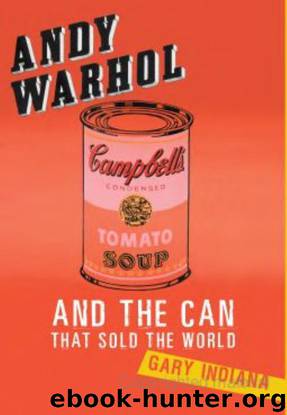Andy Warhol and the Can That Sold the World by Gary Indiana

Author:Gary Indiana
Language: eng
Format: mobi, epub
Tags: Art, Social Science, Biography & Autobiography, Architects, General, Photographers, Artists, Contemporary (1945-), Pop Art, Avant-Garde (Aesthetics), Criticism & Theory, History
ISBN: 9780465020980
Publisher: Basic Books
Published: 2007-01-02T05:00:00+00:00
FOUR
There is nothing ambiguous about a soup can. But a painting of a soup can, in 1962, bristled with suggestiveness. It represented, some thought, an indictment of quantity over quality. It could be related to widespread uneasiness with American materialism, its sexual repressiveness, its racism, the ugliness of its cities and towns. It could say: “This is what we eat, and this is what we are.”
From a different perspective, the unembellished, flat commercial image, inserted into the “sacred space” of art, was as fresh as a brisk wind, blowing away old ideas about how images affect people and what images compel their attention.
Pop could mean “populist” or “popular,” as you preferred.
The equalizing effect of Warhol’s technique on the imagery of American popular culture emphasized the omnipresence of media images. The naked, isolated soup cans repudiated the idea of “subjectivity.” Everything “outside” became the same thing, in a sense, as a soup can.
Warhol found the perfect metaphor for what was happening in the middle-class world of the affluent society. The Soup Cans were insouciant, defiant, impeccably unembellished examples of what novelist William Burroughs had termed “the naked lunch at the end of the newspaper fork,” acerbic “no comment” comments on the previous decade’s unbearable conformism, emblems of the social and political heterodoxy spreading through American society. They were banal. They were visionary. They were works of obdurate stupidity radiating the aptness of genius. They have never lost their iconic punch, perhaps because they transmuted the banality of a specific, familiar object into a wink of nonconformity—the kind of dissonance and contradiction in which ever-growing masses of people, immersed in an environment indistinguishable from advertising, now live.
Warhol was a protean maker of meaningful images remarkable for their apparent meaninglessness. Their neutrality made the viewer’s reaction the true subject of the work. When you looked at a Warhol painting, the painting blankly stared back. Warhol rewired your perception of what you already knew. He forced your attention on the elaborately constructed nature of society, its labor-intensive artifice, the complex design of images and objects that were taken for granted as “natural.” Other Warhol works may have had a greater effect on aesthetic perception than the Soup Cans. But no Warhol pictures are “perfect” in the same sense that the Campbell’s Soup Cans are perfect. Everything else Warhol painted, filmed, tape-recorded, videotaped, photographed, or simply attached his name to carries a vestige of personal idiosyncrasy and “differentness.”
The Soup Can paintings mocked the importance placed on art by timeless criteria of aesthetics. They scrambled the categories of “major” and “minor,” “commercial art” and “fine art.” They moved the work of art into the realm of objects previously unperceived as “commodities.” The art gallery and the supermarket drew closer together.
The Soup Can effect was not to rescue American banalities from banality, but to give banality itself value. After some initial hesitance about what he was doing, Warhol never wavered.
The Soup Cans were of their time, and about their time. Perhaps their most salient quality is that,
Download
Andy Warhol and the Can That Sold the World by Gary Indiana.epub
This site does not store any files on its server. We only index and link to content provided by other sites. Please contact the content providers to delete copyright contents if any and email us, we'll remove relevant links or contents immediately.
The Secret History by Donna Tartt(18208)
Red Sparrow by Jason Matthews(5201)
Harry Potter 02 & The Chamber Of Secrets (Illustrated) by J.K. Rowling(3558)
In a Sunburned Country by Bill Bryson(3375)
Drawing Cutting Edge Anatomy by Christopher Hart(3293)
Figure Drawing for Artists by Steve Huston(3274)
Harry Potter and the Prisoner of Azkaban (Book 3) by J. K. Rowling(3117)
The Daily Stoic by Holiday Ryan & Hanselman Stephen(3112)
Japanese Design by Patricia J. Graham(3004)
The Roots of Romanticism (Second Edition) by Berlin Isaiah Hardy Henry Gray John(2822)
Make Comics Like the Pros by Greg Pak(2760)
Stacked Decks by The Rotenberg Collection(2695)
Harry Potter and the Deathly Hallows (7) by J.K. Rowling(2553)
Draw-A-Saurus by James Silvani(2509)
Tattoo Art by Doralba Picerno(2494)
On Photography by Susan Sontag(2492)
Foreign Devils on the Silk Road: The Search for the Lost Treasures of Central Asia by Peter Hopkirk(2389)
Churchill by Paul Johnson(2371)
The Daily Stoic by Ryan Holiday & Stephen Hanselman(2350)
